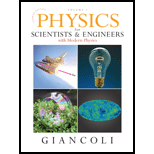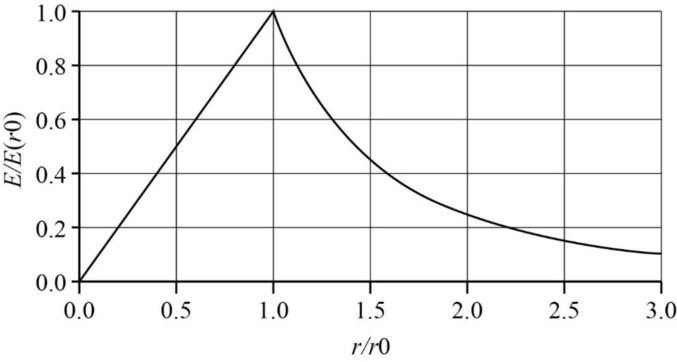
Concept explainers
(III) Repeat Problem 19 assuming the charge density ρE increases as the square of the distance from the center of the sphere, and ρE = 0 at the center.
We assume the total charge is still Q, and let ρE = kr2. We evaluate the constant k by calculating the total charge, in the manner of Example 22-5.
(a) The electric field outside a charged, spherically symmetric volume is the same as that for a point charge of the same magnitude of charge. Integrating the electric field from infinity to the radius of interest gives the potential at that radius.
(b) Inside the sphere the electric field is obtained from Gauss’s Law using the charge enclosed by a sphere of radius r.

Integrating the electric field from the surface to r < r0 gives the electric potential inside the sphere.
(c) To plot, we first calculate
Want to see the full answer?
Check out a sample textbook solution
Chapter 23 Solutions
Physics for Scientists and Engineers, Vol 1 (Chapters 1-20)
Additional Science Textbook Solutions
University Physics (14th Edition)
The Cosmic Perspective Fundamentals (2nd Edition)
Conceptual Physical Science (6th Edition)
Essential University Physics: Volume 2 (3rd Edition)
Physics for Scientists and Engineers: A Strategic Approach, Vol. 1 (Chs 1-21) (4th Edition)
The Cosmic Perspective (8th Edition)
- Can you arrange the two point charges q1=2.0106C and q2=4.0106C along the x-axis so that E=0 at the origin?arrow_forwardA spherical lubber balloon carries a total charge Q distributed uniformly over its surface. At r=0 , the radius of the balloon is R. The balloon is then slowly inflated until its radius reaches 2R at the time t0 . Determine the electric field due to this charge as a function of time (a) at the surface of the balloon, (b) at the surface of radius R, and (c) at the surface of radius 2R. Ignore any effect on the electric field due to the material of the balloon and assume that the radius increases uniformly with time.arrow_forwardA long copper cylindrical shell of inner radius 2 cm and outer radius 3 cm surrounds concentrically a charged long aluminum rod of radius 1 cm with a charge density of 4 pC/m. All charges on the aluminum rod reside at its surface. The inner surface of the copper shell has exactly charge to that of the aluminum rod while the outer surface of the copper shell has the same charge as the aluminum rod. Find the magnitude and direction of the electric field at points that are at the following distances from the center of the aluminum rod: (a) 0.5 cm, (b) 1.5 cm, (c) 2.5 cm, (d) 3.5 cm, and (e) 7 cm.arrow_forward
- This equation is for the electric field of a uniform ring which is charged and is at point z which is perpendicular to the center of the ring. (it means z=0 is part of the plane in which the ring is in). R=radius of ring, Q= total charge of ring, k= coulomb's constant. If k=1 units, Q=1 units, R=8 units, what is Ering, z when z=6 units?arrow_forwardA simple model of a water molecule treats it as two protons (H+ ) bound to a doublycharged oxygen ion (O 2-). Picture such a water molecule with two protons located onthe y-axis at y = ±76 pm and the oxygen atom (charge -2e) located on the negative xaxis at x = -59 pm. Determine the total electric dipole moment in unit vector notation ofthe water molecule. See figure 21-43 (no figure was attached to this practice problem)arrow_forward

 College PhysicsPhysicsISBN:9781285737027Author:Raymond A. Serway, Chris VuillePublisher:Cengage Learning
College PhysicsPhysicsISBN:9781285737027Author:Raymond A. Serway, Chris VuillePublisher:Cengage Learning

